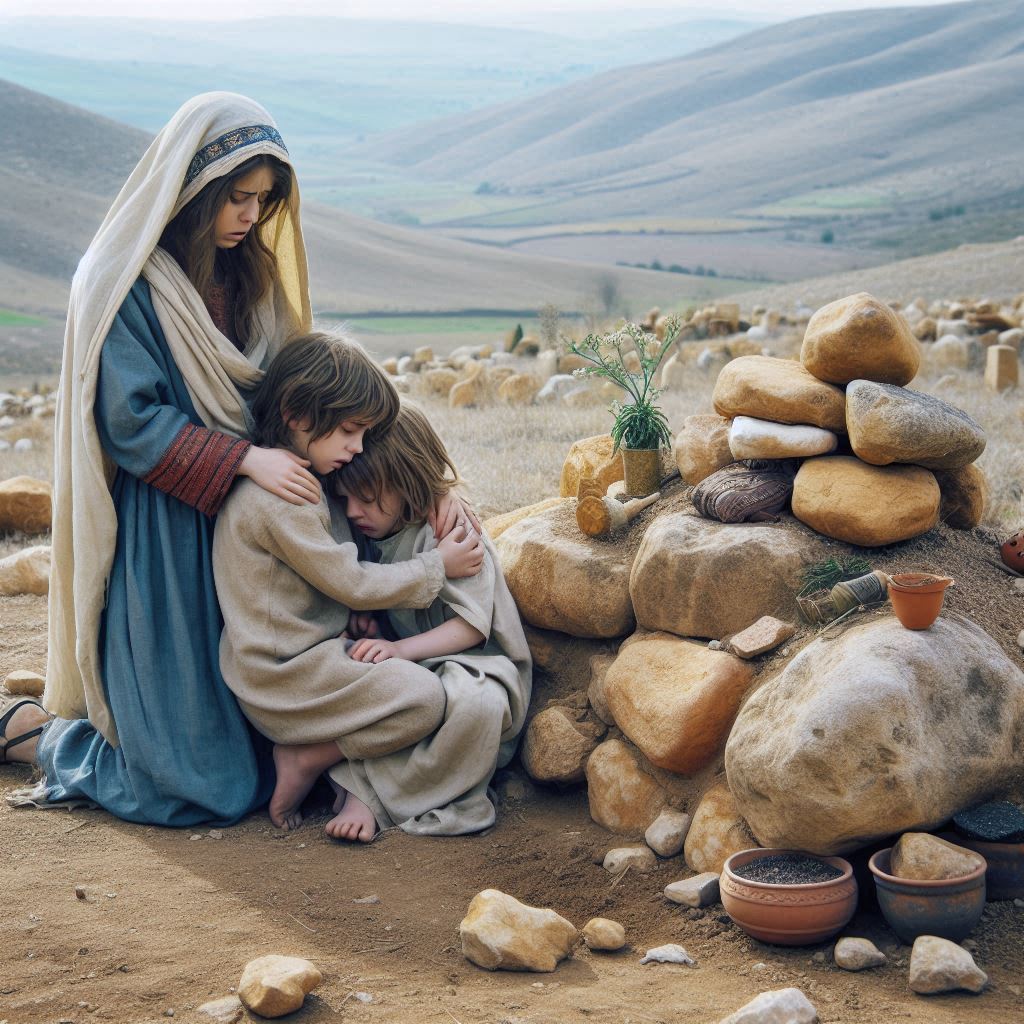We are still on the topic of burial for people who were executed, which hits close to home in these months of grief and mourning–for people who have a grave to weep on, and for those who are waiting to see if their loved ones return home alive or dead. On Saturday, we saw Yarden Bibas return home from almost 500 days in Hamas captivity; his wife Shiri and two kids Ariel (5) and Kfir (1) are still in captivity and there are grave fears for their lives. While in captivity, Yarden was told by his captors that his family members were dead, but there has been so much deceit about these matters that we do not know for sure. But we fear and tremble. Throughout the last couple of weeks, parents and siblings and spouses of people who are feared to be dead, or confirmed dead, have talked about how meaningful it would be to have a grave. And I can say that, as our mourning for my dad continues, his grave, in the beautiful secular cemetery Menuha Nekhona in Kiriat Tivon is a focal point for many family members.
The casualties of the massacre and war, and the hostages, are deeply mourned; so was my father, whose funeral was attended by hundreds of people. But yesterday’s daf, which made me think of the opera Dead Man Walking, raised a lot of questions about the propriety and spiritual meaning of public mourning for people who perhaps didn’t earn love and grief because of horrific crimes they committed. The way this is formulated by the sages in Sanhedrin 47 is this: What, and who, do we observer burial rituals and eulogies for? Is it to prevent a desecration of the dead (which has meaning for family members and friends), or to absolve their wrongdoing (which is an individual morality issue)?
The sages proceed to examine this question through a series of biblical quotes, most of which support the idea that funerary rites are for the living, rather than for the dead. One notable example is this one:
תָּא שְׁמַע: הֱלִינוֹ לִכְבוֹדוֹ, לְשַׁמֵּעַ עָלָיו עֲיָירוֹת, לְהָבִיא לוֹ מְקוֹנְנוֹת, לְהָבִיא לוֹ אָרוֹן וְתַכְרִיכִין – אֵינוֹ עוֹבֵר עָלָיו, שֶׁכׇּל הָעוֹשֶׂה אֵינוֹ אֶלָּא לִכְבוֹדוֹ שֶׁל מֵת. הָכִי קָאָמַר: כׇּל הָעוֹשֶׂה לִכְבוֹדוֹ שֶׁל חַי, אֵין בּוֹ בִּזָּיוֹן לַמֵּת.
The Gemara suggests: Come and hear a proof from a baraita: If one left his deceased relative unburied overnight for the sake of his honor, for example, in order to assemble the people from the neighboring towns for the funeral, or to bring him professional lamenters, or to bring him a coffin or shrouds, he does not transgress the prohibition of “his body shall not remain all night,” as anyone who acts in such a manner does so only for the sake of honoring the dead. This indicates that the eulogy and other funeral rites are performed to honor the deceased. The Gemara rejects this argument: This is what the baraitais saying: Anyone who acts in such a manner for the sake of honoring the living does not transgress the prohibition, as there is no degradation of the dead.
This scenario involves a relative of a dead man who leaves him unburied overnight in order to organize a respectable funeral that requires out-of-town guests, lamenters, or supplies. To the extent that the funeral organizer is doing so in order to provide the proper funerary experience for the people left behind, the delay in burial is permissible.
The Talmud then goes into a somewhat creepy ghost story. The issue is: should people be buried according to their righteousness?
לֹא הָיוּ קוֹבְרִין כּוּ׳. וְכׇל כָּךְ לָמָּה? לְפִי שֶׁאֵין קוֹבְרִין רָשָׁע אֵצֶל צַדִּיק, דְּאָמַר רַבִּי אַחָא בַּר חֲנִינָא: מִנַּיִן שֶׁאֵין קוֹבְרִין רָשָׁע אֵצֶל צַדִּיק? שֶׁנֶּאֱמַר: ״וַיְהִי הֵם קֹבְרִים אִישׁ וְהִנֵּה רָאוּ אֶת הַגְּדוּד וַיַּשְׁלִיכוּ אֶת הָאִישׁ בְּקֶבֶר אֱלִישָׁע וַיִּגַּע הָאִישׁ בְּעַצְמוֹת אֱלִישָׁע וַיְחִי וַיָּקׇם עַל רַגְלָיו״.
§ The mishna teaches that they would not bury the executed transgressor in his ancestral burial plot, but rather in one of two special graveyards set aside for those executed by the court. The Gemara explains: And why is all this necessary? It is necessary because a wicked man is not buried next to a righteous man. As Rav Aḥa bar Ḥanina says: From where is it derived that a wicked man is not buried next to a righteous man? As it is stated: “And it came to pass, as they were burying a man, that behold, they spied a raiding party; and they cast the man into the tomb of Elisha; and as the man came there, he touched the bones of Elisha, and he revived and stood up on his feet” (II Kings 13:21). The man, who was not righteous, was miraculously resurrected so that he would not remain buried alongside Elisha.
אֲמַר לֵיהּ רַב פָּפָּא: וְדִילְמָא לְאִיקְּיוֹמֵי ״וִיהִי נָא פִּי שְׁנַיִם בְּרוּחֲךָ אֵלָי״? אֲמַר לֵיהּ: אִי הָכִי, הַיְינוּ דְּתַנְיָא: עַל רַגְלָיו עָמַד, וּלְבֵיתוֹ לֹא הָלַךְ.
Rav Pappa said to Rav Aḥa bar Ḥanina: What proof is there from here? Perhaps the man was resurrected in order to fulfill Elisha’s request of Elijah: “I pray you, let a double portion of your spirit be upon me” (II Kings 2:9), as now Elisha resurrected two people, the son of the Shunammite woman and this man, as opposed to Elijah, who had resurrected only one person? Rav Aḥa bar Ḥanina said to Rav Pappa: If so, there is a difficulty, as is this a reasonable explanation in light of what is taught in a baraita: The words “and stood up on his feet” indicate that he arose, but he did not go to his home. The man did not in fact live again but for a moment, indicating that he was resurrected not in order to fulfill Elisha’s request for a double portion of Elijah’s spirit, but in order to prevent the disgrace of having a wicked man buried next to Elisha.
אֶלָּא ״וִיהִי נָא פִּי שְׁנַיִם״, הֵיכִי מַשְׁכַּחַתְּ לַהּ דְּאַחֲיֵיא? אֲמַר לֵיהּ רַבִּי יוֹחָנָן: שֶׁרִיפֵּא צָרַעַת נַעֲמָן, שֶׁהִיא שְׁקוּלָה כְּמֵת, דִּכְתִיב ״אַל נָא תְהִי כַּמֵּת״.
The Gemara asks: But if so, with regard to the verse: “I pray you, let a double portion of your spirit be upon me,” where do you find that Elisha resurrected a second person? Rabbi Yoḥanan said to him: That request was fulfilled when he cured Naaman’s leprosy (see II Kings, chapter 5), an affliction that is considered to be equivalent to death, as it is written with regard to Miriam’s leprosy: “Let her not be as one dead” (Numbers 12:12).
וּכְשֵׁם שֶׁאֵין קוֹבְרִין רָשָׁע אֵצֶל צַדִּיק, כָּךְ אֵין קוֹבְרִין רָשָׁע חָמוּר אֵצֶל רָשָׁע קַל. וְלִיתְקוֹן אַרְבַּע קְבָרוֹת! שְׁנֵי קְבָרוֹת גְּמָרָא גְּמִירִי לַהּ.
The mishna teaches that two graveyards were established for the burial of those executed by the court, one for those who were killed by decapitation or strangulation, and one for those who were stoned or burned. The Gemara explains: Just as a wicked man is not buried next to a righteous man, so too an extremely wicked man, i.e., one who committed a grave offense is not buried next to a less wicked man, i.e., one who committed a less severe offense. The Gemara challenges: If so, let them establish four different graveyards, one for each of the different modes of judicial execution. The Gemara answers. It is learned as a tradition that there are two graveyards for those executed by the court, and no more.
This is pretty wild: it is suggested here that burying wicked people alongside righteous people may result in the unintended consequence of those wicked people being resurrected. Moreover, wicked people should not be mixed up with less wicked people in death (as in life). And all this raises another question: does a person who was killed for wrongdoing receive atonement in death? Abaye says no: the dead person did not repent.
אֲמַר לֵיהּ אַבָּיֵי: מִי סָבְרַתְּ מֵת מִתּוֹךְ רִשְׁעוֹ הָוְיָא לֵיהּ כַּפָּרָה? מֵת מִתּוֹךְ רִשְׁעוֹ לָא הָוְיָא לֵיהּ כַּפָּרָה, דְּתָנֵי רַב שְׁמַעְיָה: יָכוֹל אֲפִילּוּ פֵּירְשׁוּ אֲבוֹתָיו מִדַּרְכֵי צִיבּוּר יִטַּמֵּא? תַּלְמוּד לוֹמַר ״בְּעַמָּיו״ – בְּעוֹשֶׂה מַעֲשֵׂה עַמָּיו.
Abaye said to Rav Yosef: Do you maintain that one who dies in his state of wickedness without repenting achieves atonement? This is not the case, as one who dies in his state of wickedness without repenting does not achieve atonement, as Rav Shemaya taught in a baraita: The verse states with regard to the priests: “There shall none be defiled for the dead among his people, but for his kin that is near to him, for his mother, and for his father” (Leviticus 21:1–2). One might have thought that even if his father had become an apostate and separated himself from the ways of the community, his son the priest shall become ritually impure in order to bury him. Therefore, the verse states: “Among his people,” which teaches that a priest may become ritually impure only for one who performs the actions of his people, that is, one who conducts himself as a Jew. This indicates that one who dies in his wickedness without repenting does not achieve atonement.
Rava, by contrast, thinks that those who were executed, and thus did not die a natural death, did not have an opportunity to repent independently of the sentence, and thus do receive atonement.
אֲמַר לֵיהּ רָבָא: מִי קָא מְדַמֵּית נֶהֱרָג מִתּוֹךְ רִשְׁעוֹ לְמֵת מִתּוֹךְ רִשְׁעוֹ? מֵת מִתּוֹךְ רִשְׁעוֹ, כֵּיוָן דְּכִי אוֹרְחֵיהּ קָמָיֵית – לָא הָוְיָא לֵיהּ כַּפָּרָה. נֶהֱרָג מִתּוֹךְ רִשְׁעוֹ, כֵּיוָן דְּלָאו כִּי אוֹרְחֵיהּ מָיֵית – הָוְיָא לֵיהּ כַּפָּרָה.
Rava said to Abaye: Are you comparing one who was killed in his state of wickedness to one who died in his state of wickedness? An unrepentant sinner who died in his state of wickedness does not achieve atonement, since he died a natural death and there was nothing to bring about his atonement. But a transgressor who was killed in his state of wickedness achieves atonement, even without repentance, since he did not die a natural death, but rather he was executed.
And if so, let’s return to the insights from the previous page: we allowed for the possibility that relatives might experience private grief after an execution, regardless of public rituals; but if, indeed, the wicked who are executed receive atonement after death, that paves the way to public mourning as well.
The conversation then turns to the question of honoring the dead and buried: when, and under which circumstances, can a dug grave be reused after the body in it is moved for some reason. These are the sorts of questions that we have to address today when dealing with antiquities. The Israel Antiquities Authority gets called in every time a relic is found close to a highway, as they must guarantee respect for possible human remains. The taboo around disrespecting burial sites is at the heart of Stephen King’s terrifying Pet Sematary, reinforcing the perennial disturbing nature of the situations in which the boundary between the dead and the living becomes too thin for comfort.

